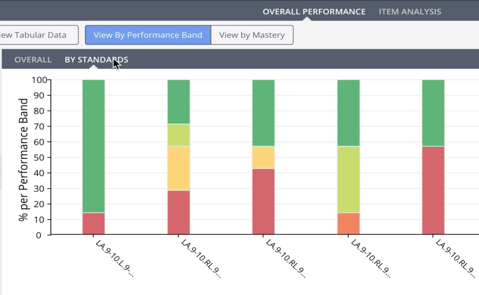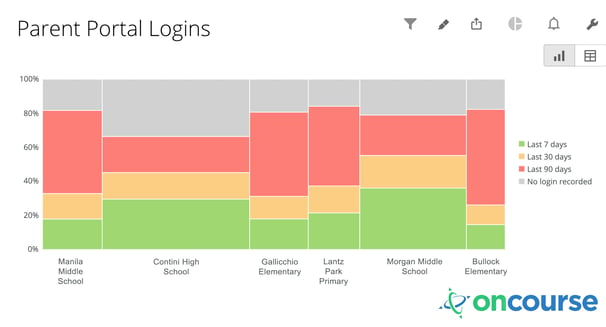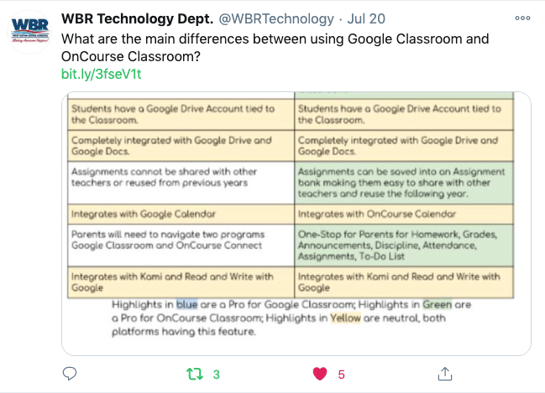After working closely with schools transitioning from Google Classroom to a full LMS, we have identified eight indicators districts should consider before embarking on their own upgrade project.
When schools were in a COVID-19 tailspin, Google Classroom was a parachute. Free, fast, and frictionless.
Now, school leaders are cautiously approaching the idea of transitioning to a Learning Management System (LMS) with a deeper feature set more aligned to their academic priorities.
When proposing this idea to staff, a common question to expect is: “But isn’t Google Classroom an LMS?”
Knowing your System
Google Classroom and Microsoft Teams are document management systems (aka productivity suites.) These systems are wildly effective at meeting the first of three pillars of online learning program: Access.
Students and teachers must have equitable access to devices, collaborative documents, web conferencing, and feedback tools. Google, Microsoft, or Apple thrive here due to the congruence of need with their core clientele, corporate workplaces.
This is also why these tools fall short in the next two pillars. Alignment, connecting curriculum, tech-enhanced assessment, and indicators of student mastery of academic standards, and Accountability, ensuring that parents and administrators have the transparency needed to support teachers and students.
These are areas where the traditional LMS shines, because they were built specifically for education.
Evaluating an LMS
The decision to add new technology should not be made flippantly, especially not when teachers are experiencing historic levels of stress. If you read the tips below and feel that your district is ready to consider looking into an LMS, here are two suggested prerequisites that will make your implementation more amenable to everyone involved.
Prerequisite 1: Make sure any LMS you evaluate is integrated with your productivity suite.
A fast way to alienate teachers is to choose a system that can’t take advantage of all the content they’ve created. Some LMS products are well-integrated into systems like Google Drive and can help to make a transition more seamless. This makes your implementation feel more like an augmentation, and less of a replacement.
Prerequisite 2: Prioritize interoperability with your Student Information System.
In a recent survey, 93% of school leaders believed that LMS features should be integrated into their SIS (OnCourse, 2020). Adding technology to stressed staff members won’t be palatable without picking up meaningful time-savings elsewhere. If your teachers have ever asked about getting Google connected to their grade books, now may be the time to start thinking about an all-in-one software. Most staff who convert to a SIS+LMS combo reported saving between 30 minutes to 2 hours weekly on manual data entry.
With those prerequisites in mind, here are tips for when you should and should not transition from Google Classroom to a full Learning Management System.
4 Indicators that it’s a GOOD Time to Transition
- The district can devote coaches/champions to the implementation project
One of the reasons tools like Google Classroom are popular is because of usability. They are quick-start tools with a low learning curve. What districts are discovering, however, is that the bill comes due in the back-end of the process. Staff have to do time-consuming data entry to upkeep grades and rosters while also using plug-ins to compensate for a lack of certain out-of-the-box features. Conversely, LMS products have higher ability but lower usability. A deeper feature set always comes with a higher learning curve, so schools can expect to need a little extra help as staff gets acclimated to powerful new tools at their disposal.
- District is operating without meaningful data on student mastery of standards
The tools inside productivity suites (Google/Microsoft Forms) are terrific for quick formative exercises, but they are inadequate for more rigorous assessments. Most LMS systems have stronger assessment tools like tech-enhanced questions, a standards-aligned item bank, and data analytics.
They offer things like advanced math scoring and math formula builders that give students valuable practice with tools they’ll need on summative assessments.
- Parent engagement is low
Google Classroom is terrific for many things, but keeping parents informed is not its strongest suit. This is another reason to consider an LMS that integrates with your SIS, allowing parents to have a single place to go to for all their student’s work. In a recent survey, 80% of school leaders believed that parent engagement was improved by integrating their LMS into their parent portal.
Your Student Information System is also likely to provide better parent/student engagement analytics, making it easy to spot populations that need help getting connected.
- Community has concerns about student data privacy
In the rush to remote learning, most districts got students connected first and asked questions later. Even schools that had been steadfast in not turning students over to Google (due to dubious data harvesting practices under scrutiny in recent lawsuits, some involving schoolchildren) had little choice but to use free/low cost tools.
Now that the dust is settling, some communities have expressed concern about companies spying on student data.
For many districts, the trade-off is well worth it. However, if the conversation about student data tracking hasn’t had a substantive discussion in your district, it’s a good time to make that happen.
4 Indicators that it’s a BAD Time to Transition
- When an LMS project isn’t articulated in and aligned to,academic goals
There are many reasons to move from a productivity suite like Google Classroom to a full LMS. Test banks can improve the rigor of formative assessments. Staff can get better data on student strengths and weaknesses. Administrators can provide better support.But with more functionality comes a higher learning curve. When staff haven’t internalized the academic goals behind the switch, a transition can feel like change-for-changes-sake and can hamstring the momentum of your implementation.One administrator in Salem County, NJ reflected on converting to the OnCourse SIS + LMS from Google Classroom. “The integration with Google has been a real perk. The varying level of test questions in OnCourse helps manage the level of rigor to meet student needs and provide the right amount of challenge for growth and achievement, not frustration and failure.”
Articulating the impact on student achievement, as this administrator did above, can go a long way to keep staff momentum through a transition.
- When you haven’t gathered teacher buy-in
Few things are more frustrating than hitting your groove with a technology tool, only to have it replaced. Good news is, many LMS systems can integrate with Google to take advantage of its best features, while layering on better academic features.Districts should take the time to build teacher buy-in, like West Baton Rouge Schools did when converting from Google to a combo that included OnCourse SIS + LMS + Google.

The district technology department gathered feedback on the pluses and minuses of both systems and created a comparison document to acclimate their users to the idea of a transition.
- When your staff is implementation-weary
There’s never a perfect time for change. Even with the best plan and the best product, there will always be resistance to adding another project. Sometimes leaders have the equity to push through resistance in service of a bigger vision; however, if your district is in the middle of an implementation spree (curriculum, redistricting, academic programs, etc.) – it may be wise to carefully consider the timing.
- When your desired LMS is fresh off an acquisition
Some companies like OnCourse developed their SIS and LMS technology to be seamlessly integrated. Other large ed-tech companies have spent millions of dollars to buy LMS and SIS products and bolt them together. Before hitching your wagon to a vendor growing through acquisition, make sure that the integrations are actually functional and that the company has recovered from the disruptions (and price increases) that follow a buying spree. More disparate codebases equal more points of failure. Keep in mind that 80% of the time, your staff will use 20% of the features of the product you choose. So don’t get too enchanted with bells and whistles and ensure that the fundamentals are solid.
For more information about the integrated OnCourse SIS and LMS, contact Sam Morgan at [email protected].




